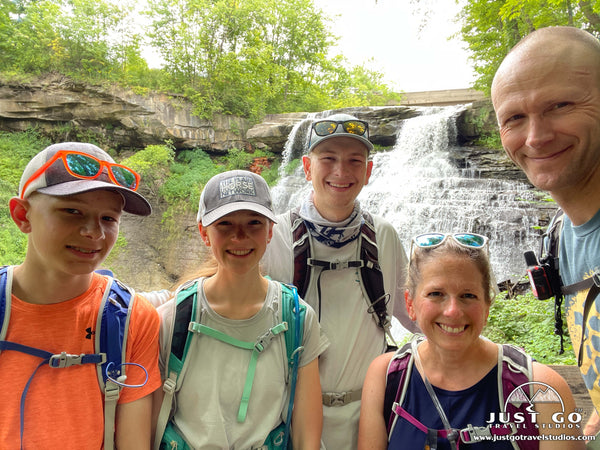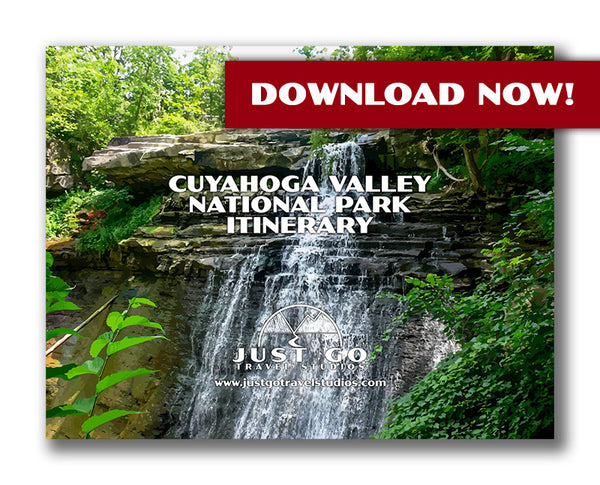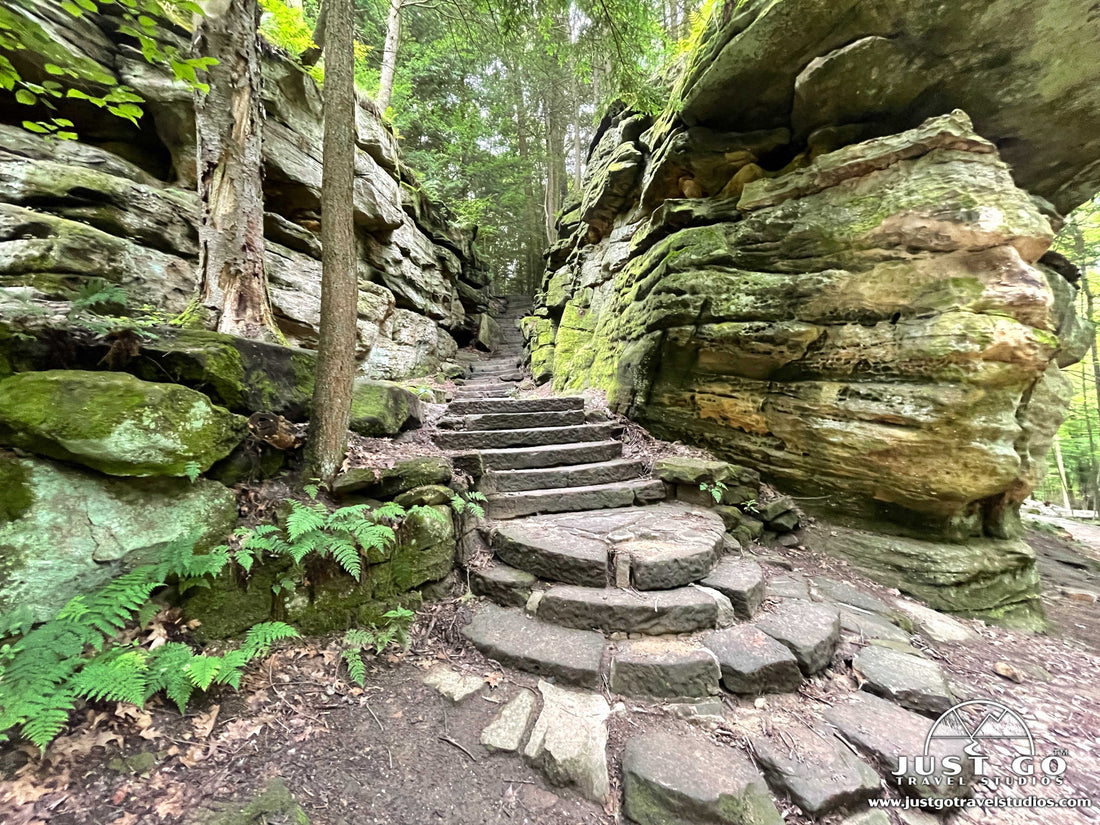
Cuyahoga Valley National Park: Things to Do, Hiking Trails, Maps & More
Peter BrahanNestled between the cities of Cleveland and Akron, Cuyahoga Valley National Park has more of an urban feel than most other national parks. However, its proximity to nearby cities and major roadways is the very reason for its establishment and makes it one of the most accessible national parks in the United States. Cuyahoga Valley serves as a place for visitors to escape city life and enjoy nature.
Encompassing 33,000 acres, the park offers over 125 miles of trails to explore its dense forests, wetlands, waterfalls, rivers, historic sites, and farmsteads. Two of the park’s most popular attractions, the Ohio and Erie Canal Towpath Trail and the Cuyahoga Valley Scenic Railroad, run alongside the Cuyahoga River, the centerpiece of the park. County parks located within Cuyahoga Valley National Park (operated by Cleveland and Summit Metroparks) provide even more options for exploring and recreating in the valley!
Cuyahoga Valley National Park strives to offer a variety of activities and attractions that are accessible to everyone regardless of age or ability. Whether you prefer riding the rails, exploring hiking trails or learning about the area’s history, Cuyahoga Valley National Park has something for everyone! You’ll need at least a full day to explore the highlights of the park. If you enjoy hiking but also plan to bike the Towpath Trail and/or ride the train, we recommend allowing two days to explore. We hope this guide will help you make the most of your trip to Cuyahoga Valley National Park!
Before you head to Cuyahoga Valley National Park, be sure to pick up a copy of our downloadable Cuyahoga Valley National Park Itinerary, which covers the best things to do at Cuyahoga Valley. We also include details on hiking trails, where to stay, what to pack and other places to visit while you are in the Cuyahoga Valley area.
CUYAHOGA VALLEY NATIONAL PARK HISTORY
Before western explorers arrived, the area now known as the lower Cuyahoga River was an important part of trade routes for Native Americans. They referred to the river as “Ka-ih-ogh-ha”, which translates to crooked. European settlers seeking rich land to farm began arriving in the late 1700s. However, life in this area was challenging with limited transportation options for people and goods.
Seeing a need to create a link in an inland shipping network, plans were developed to create a hand-dug canal by diverting water from the lower Cuyahoga River. The Ohio & Erie Canal, connecting the Ohio River with Lake Erie, opened in 1827. The canal operated for decades—serving as a commercial waterway and bringing prosperity to the region. By 1850, Ohio was the third most populated state.
The desire to find a more efficient way to move people and goods brought the railroad to the Cuyahoga Valley in the 1880s. Decreased use of the canals and extensive flood damage in 1913, resulted in the eventual abandonment of the canal.
Sadly, the rapid industrialization of the area led to severe pollution of the Cuyahoga River. In fact, the river was so filled with trash and debris coated with oil that it caught fire multiple times between the late 1800s and mid-1900s. Thankfully, an environmental movement in the 1970s brought attention to the poor health of the nation’s waterways and the need for change.
Although the Cuyahoga Valley provided recreation for urban dwellers as early as the late 1800s, actual park development in the area didn’t occur until the early 1900s with the establishment of metropolitan parks. And, in the 1930s, the Civilian Conservation Corps was responsible for building structures and trails in some areas of the park, which are now known as the Ledges and Kendall Lake. However, concerns that urban sprawl would ruin the area’s natural spaces led conservationists to seek federal protection for the land and waterways. In December 1974, Gerald Ford signed a bill establishing the Cuyahoga Valley National Recreation Area. 26 years later, in October 2000, the area was redesignated as a national park.
Fun Facts:
- It is the only national park in the state of Ohio.
- It is the only national park that originated as a national recreation area.
- Since its redesignation as a national park, it has routinely been rated as one of the top ten most visited national parks in the US with over 2 million visitors per year.
NORTHERN AREA OF CUYAHOGA VALLEY NATIONAL PARK

Cuyahoga Valley National Park northern area map, courtesy of the National Park Service
The northern section of Cuyahoga Valley National Park, closest to Cleveland, is home to the primary boarding site for the Cuyahoga Valley Scenic Railroad and the Canal Exploration Center. There are also two great Cleveland Metroparks adjacent to the northern section of the park--Bedford Reservation and Brecksville Reservation.
When visiting the northern area of Cuyahoga Valley, our recommendations include:
Rockside Station
Rockside Station is located at the far northern end of the park, closest to Cleveland. It is the primary boarding site for the Cuyahoga Valley Scenic Railroad. The station was built in the early 2000s and its design reflects historic depots that were once found all along the Cuyahoga Valley Line. Even if you don’t have time for a scenic train ride, check out the exhibits inside the station, which describe the area’s railroad history, or head east over the river to access the Ohio & Erie Canal Towpath Trail.

Canal Exploration Center
Learn about the 308-mile Ohio & Erie Canal during a visit to the Canal Exploration Center, part of the Ohio & Erie National Historic Landmark. The former tavern and general store now houses interactive exhibits that allow visitors to discover why the canals were so important to a growing nation. While in the area, walk the adjacent Towpath Trail to see exhibits about the valley’s Native American heritage and other historic sites along the canals. Pick up a park brochure and a Valley Guide to help plan your visit to the park (if you haven’t already been to the park’s main visitor center in Boston Mills). The center has a small park store and picnic area. The Canal Exploration Center is open from June through Labor Day weekend. It has limited hours in the fall and closes during the winter.

Bedford Reservation--Tinkers Creek Gorge and Bridal Veil Falls
Tinkers Creek Gorge is adjacent to the park and part of the Bedford Reservation (managed by Cleveland Metroparks). Tinkers Creek Gorge can be viewed from an overlook on the Gorge Parkway. While visiting the gorge, enjoy a short hike to Bridal Veil Falls. To access the trail to the falls, park at the Bridal Veil Falls parking lot which is just past the gorge overlook. Cross the street and follow the trail which includes stairs and boardwalk sections to the observation deck.
Brecksville Reservation and Brecksville Nature Center
The Brecksville Reservation, the largest of the Cleveland Metroparks, is also adjacent to the northern area of the national park. If you have extra time while visiting Cuyahoga Valley National Park, the Brecksville Reservation is a great place to explore. The reservation has a nature center, an extensive system of trails, historical landmarks, scenic overlooks and two golf courses. One moderate hike worth checking out is the 4-mile Deer Lick Cave Loop Trail.
Hiking
There are a couple trails worth mentioning if you’d like to stretch your legs while visiting the northern section of Cuyahoga Valley National Park.- The popular Ohio and Erie Canal Towpath runs the length of the national park and beyond (about 100 miles long!). Travel the historic route of the Ohio and Erie Canal using the same path that mules walked in the 1800s to tow canal boats loaded with goods. For those looking to take an easy walk, there are several great sections of trail in the northern area of the park. Highlights include Canal Exploration Center to Tinkers Creek Aqueduct (about 1 mile roundtrip) and Station Road Bridge to Mudcatcher (about 1.5 miles roundtrip). See the NPS site for more information on these short Towpath Trail walks and more. The Towpath Trail is multi-use and wheelchair accessible.
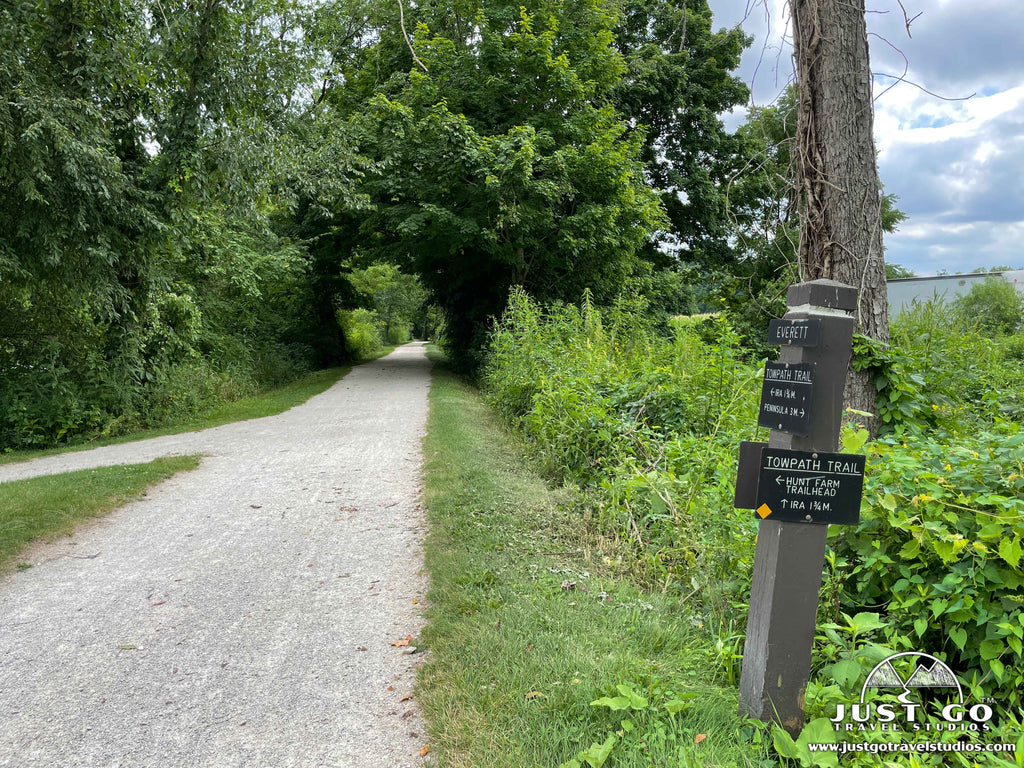
- The Hemlock Creek Trail, which connects Independence, OH to the Ohio and Erie Canal Towpath, is one of the newest scenic trails in the area. This 3.6-mile (out-and-back) paved pathway travels through the woods along Hemlock Creek and comes to an end at the junction with the Towpath Trail. To access the trail’s western end, park at Elmwood Park in Independence. Allow about 1 1/2 hours for this hike.
CENTRAL AREA OF CUYAHOGA VALLEY NATIONAL PARK

Cuyahoga Valley National Park central area map, courtesy of the National Park Service
The central area of Cuyahoga Valley National Park is home to the Boston Mill Visitor Center, beautiful waterfalls, and some of the best hikes in the park! You’ll want to allow at least a half day to explore this area.
When visiting the central area of Cuyahoga Valley National Park, our recommendations include:
Boston Mill Visitor Center
The Boston Mill Visitor Center sits at the heart of the park and is a great place to begin your adventure! The historic building was once the company store for the Cleveland-Akron Bag Company. Stop in for maps, explore the exhibits, and get suggestions from park rangers. The visitor center also has a small park store and restrooms. The Boston Mills Visitor Center is open year-round from 9:30 to 5. It is closed New Year’s Day, Thanksgiving and Christmas.


Brandywine Falls
There are lots of waterfalls in the park, but Brandywine Falls is the grandest and certainly the most popular! This impressive 60-foot cascade tumbles down over layers of Berea sandstone and shale into Brandywine Gorge. A boardwalk leads to an upper accessible viewing area for Brandywine Falls; however, the view here is partially obstructed by foliage. For the best views, continue down some stairs to the lower viewing area. Part of the walkway is suspended from the stone cliffs; and, aside from the actual waterfalls, this is the coolest spot in the Brandywine Falls area! If you’re looking to explore the area further, scroll down to the hiking section to read about the Brandywine Gorge Trail or the Stanford Trail. The Brandywine Falls Trailhead has restrooms (new as of fall 2023) and picnic tables. Note: Brandywine Falls is the busiest place in the park. The parking area is especially congested on weekends and throughout the summer between the hours of 10 am and 3 pm. Arrive early in the morning or in the evening for the best chance of avoiding the crowds.

Kendall Lake
Created by the Civilian Conservation Corps in 1935, Kendall Lake is a quiet spot to fish, hike and enjoy nature. The Kendall Lake area offers a picnic shelter, fishing pier, a network of trails and restrooms (on the lower level of the shelter). Visit the Kendall Lake trails in the fall to enjoy the beautiful fall foliage. Kendall Lake is located just west of the popular Ledges Trail off Truxell Road (Rt. 187).


Hiking
There are some great trail networks to explore in the central area of Cuyahoga Valley National Park. If you only have time to visit one area and love to hike, head to the heart of the park! We recommend the following hikes:
- Our favorite trail in the entire park is the Ledges Trail. This moderate, 2.6-mile loop trail leads through a forested landscape with the most amazing rock formations, caves, and massive, moss-covered sandstone walls! It is one of the most popular trails in the park for good reason. However, even in the busy summer months, you are sure to find solitude along sections of this stunning trail. Most of the trail is shaded, which makes a good choice for hot, summer days. For a longer hike, consider starting from nearby Pine Grove, Haskell Run or Kendall Lake trailheads. Be sure to plan ahead and pick up a map since there are lots of options! There are restrooms and picnic tables in the Ledges area. The main parking area for the Ledges Trailhead is located just off Truxell Road in Peninsula, OH. Allow 1 ½ to 2 hours to hike the Ledges Trail loop. Note: the national park does not allow climbing on these rock formations to protect the fragile habitat.

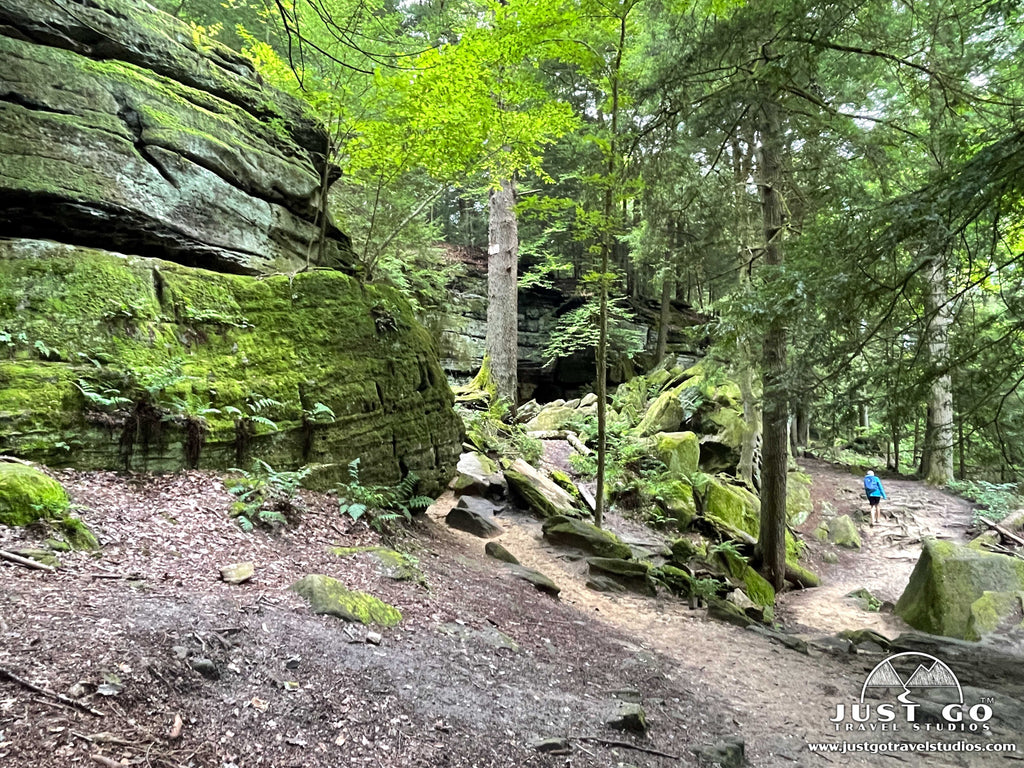

- If you are visiting Brandywine Falls and are looking to explore a little further, check out the 1.5-mile Brandywine Gorge Trail. While the falls are extremely popular, many people don’t venture beyond the viewing areas closest to the parking lot. The short hike loops through deciduous forest, along the gorge and down to the creek. If you prefer to save the best for last, hike in the clockwise direction so you’ll end with the waterfalls. Don’t miss the view from the lower viewing area at the base of the wooden stairs! Note: Brandywine Falls is the busiest place in the park. The parking area is especially congested on weekends and throughout the summer between the hours of 10 am and 3 pm. Arrive early in the morning or in the evening for the best chance of avoiding the crowds. The Brandywine Gorge Trail can be muddy so proper hiking footwear is recommended. Allow about an hour to hike the Brandywine Gorge Trail loop.

- For a longer hike that avoids the busy Brandywine Falls parking area, consider starting your hike to Brandywine Falls from the Stanford Trail. We enjoyed this moderate, 3.8-mile hike which starts (and ends) on the Stanford Trail and connects to the Brandywine Gorge Trail loop. To access the Stanford Trailhead, park in the small, designated parking area behind the large barn at the Stanford House. Both the Stanford Trail and Brandywine Gorge Trails include some hilly and potentially muddy sections, so proper hiking footwear is recommended. Allow 1 ½ to 2 hours to hike the Stanford Trail to Brandywine Falls.

- Another popular hike in the central area of the park is the Buckeye Trail to Blue Hen Falls. This moderately strenuous, 2.8-mile out-and-back hike follows the Buckeye Trail to the 15-foot Blue Hen Falls. It has an elevation gain of over 500 feet, which includes some hilly sections and a 100-foot staircase that drops down into a ravine. Yes, that means you’ll have to climb that same steep staircase on the way back! We recommend hiking shoes or boots due to some rocky and uneven terrain, plus occasional mud. If you are seeking a peaceful trail, this might not be the one for you since part of the trail runs along Highway 271. To get to the Blue Hen Falls Trail, park at the Boston Mills Visitor Center. Cross Riverview Road and follow signs to Blue Hen Falls. Allow 1 to 1 ½ hours for this hike.
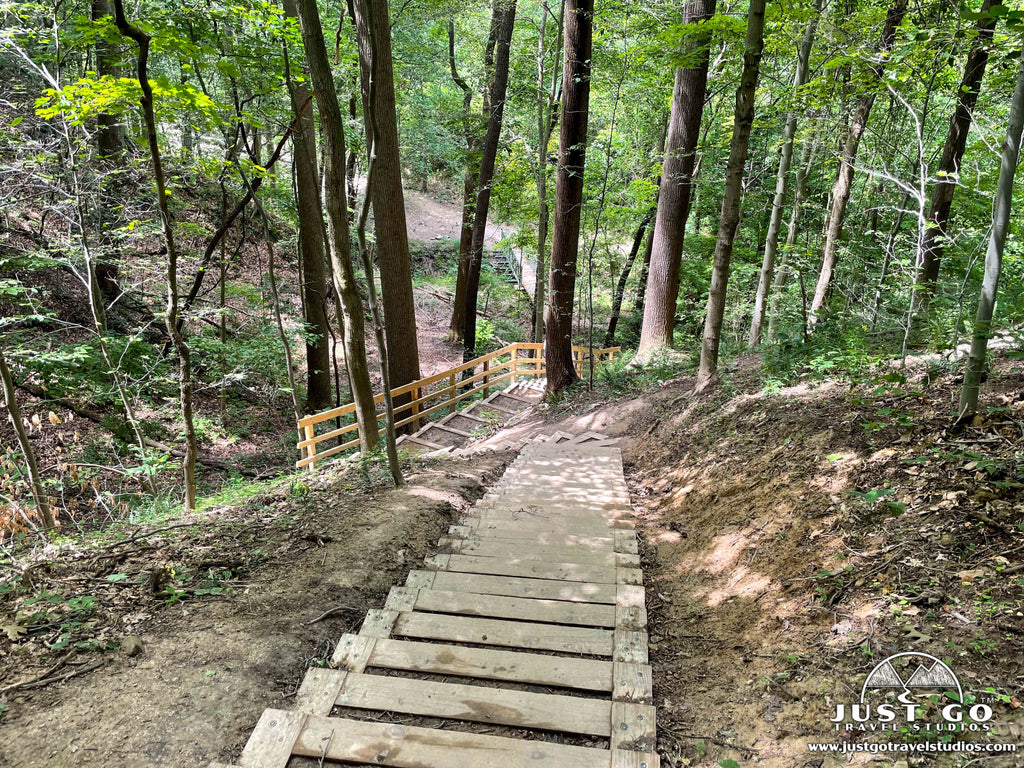
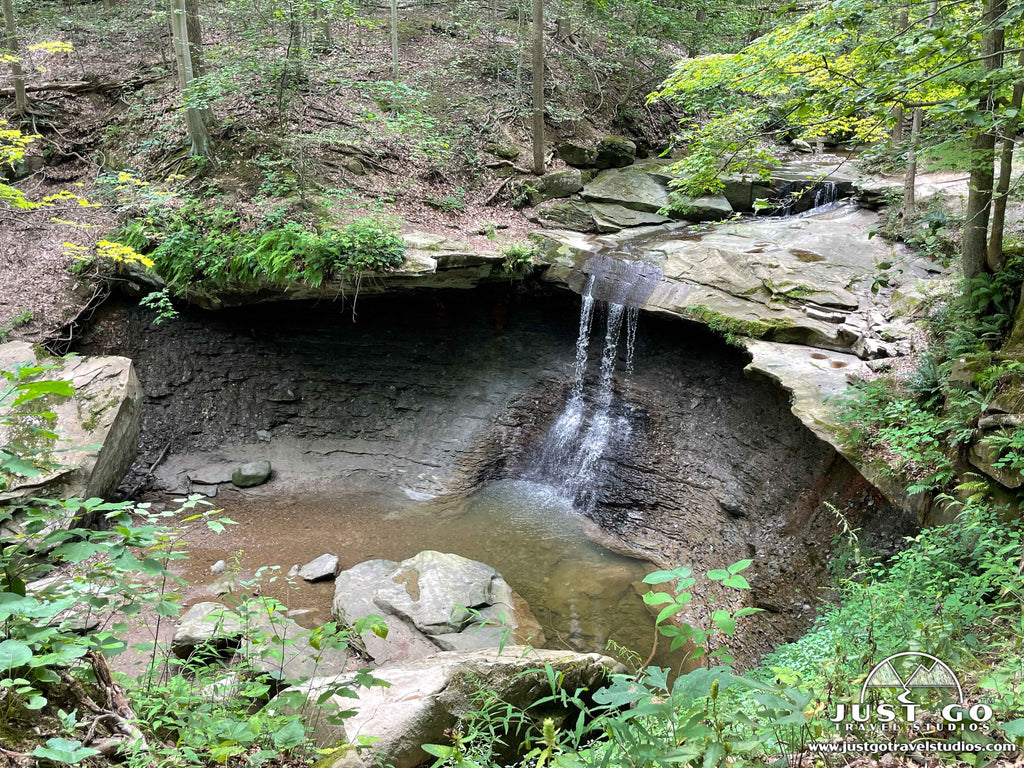
- If you are seeking a pleasant walk in the woods, check out the easy, 2-mile Pine Grove Trail. From the Pine Grove Trailhead, take the connector trail to the Pine Grove Trail loop. You can also access the Ledges Trail from the Pine Grove Trailhead. The Pine Grove Trail begins at the top of the Octagon parking lot which is located just off Truxell Road. The Pine Grove Trailhead is a major junction for the Ledges and Pine Grove Trails, both of which are a part of the Virginia Kendall Park’s interconnected trail system. Allow about an hour for this hike.
See the NPS page Hiking at Cuyahoga Valley National Park for more information on these trails and others.
SOUTHERN AREA OF CUYAHOGA VALLEY NATIONAL PARK

Cuyahoga Valley National Park southern area map, courtesy of the National Park Service
The southern area of the park is home to the Everett Covered Bridge, Hunt House, and Beaver Marsh. (If you haven’t already been to the Boston Mill Visitor Center, we recommend starting your trip there to first get oriented with the layout of the park and grab any maps you might need.)
When visiting the southern area of Cuyahoga Valley, our recommendations include:
Everett Covered Bridge
Visit the reconstructed Everett Covered Bridge, the last remaining covered bridge in Summit County, Ohio. During the 1800s, Ohio led the nation with over 2,000 covered bridges. However, most covered bridges were eventually replaced with more durable iron bridges. The original Everett Covered Bridge was destroyed by a spring storm in 1975 but was rebuilt and completed in 1986. From the parking lot, it is a short walk to reach the bridge. The Everett Covered Bridge Trailhead also provides access to nearby horse and hiking trails. The Everett Covered Bridge is located off Everett Road, ½ mile west of Riverview Road. The path to the bridge is wheelchair accessible.
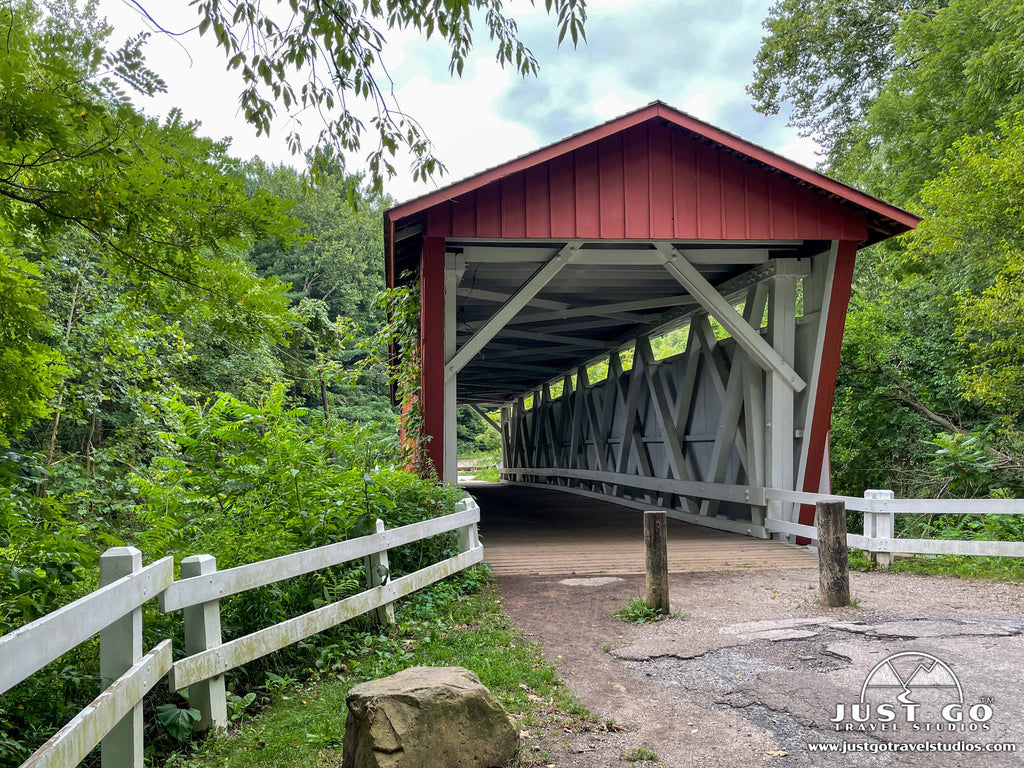
Hunt House
Hunt House is a small, seasonal visitor information center located in the southern area of the park. It offers information about nearby attractions and child-friendly nature exhibits, including the “Growing Up in Everett” exhibits outside Hunt House. It also serves as a nice rest stop for those riding bikes or walking along the Ohio & Erie Towpath Trail. Hunt House is open seasonally—Saturdays and Sundays from Memorial Day to Labor Day. The restrooms are open year-round. Park at the Hunt House Trailhead on Bolanz Road and walk across the street.


Beaver Marsh
Not only is Beaver Marsh beautiful, it is also one of the best places in the park to spot wildlife--including beavers, turtles, river otters, great blue herons, and other wetland birds! It’s hard to believe that this beautiful spot was at one time drained and occupied by a dairy farm and later an auto salvage yard! Thankfully, the NPS purchased the property, and by the mid-1980s, the park began cleaning up the site. Beavers moved back in and built dams that flooded the area and restored natural water levels. Wetlands plants flourished, creating a habitat for one of the most diverse wildlife communities in the area. To reach the Beaver Marsh viewing platforms, park at the Ira Trailhead on Riverview Road. Follow the Ira Trail for a short distance and turn left onto the Towpath Trail. Then walk ¼ mile north on the Towpath Trail to reach the boardwalk viewing area. The Ira Trailhead has restrooms and picnic tables. Beaver Marsh is also wheelchair accessible.
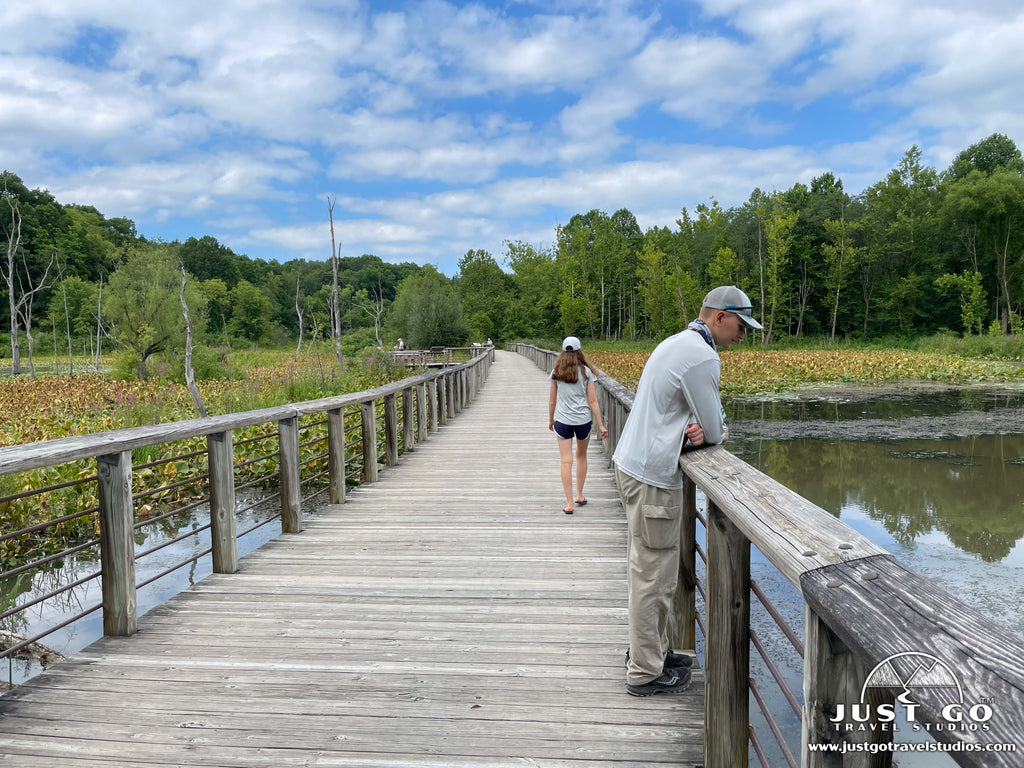
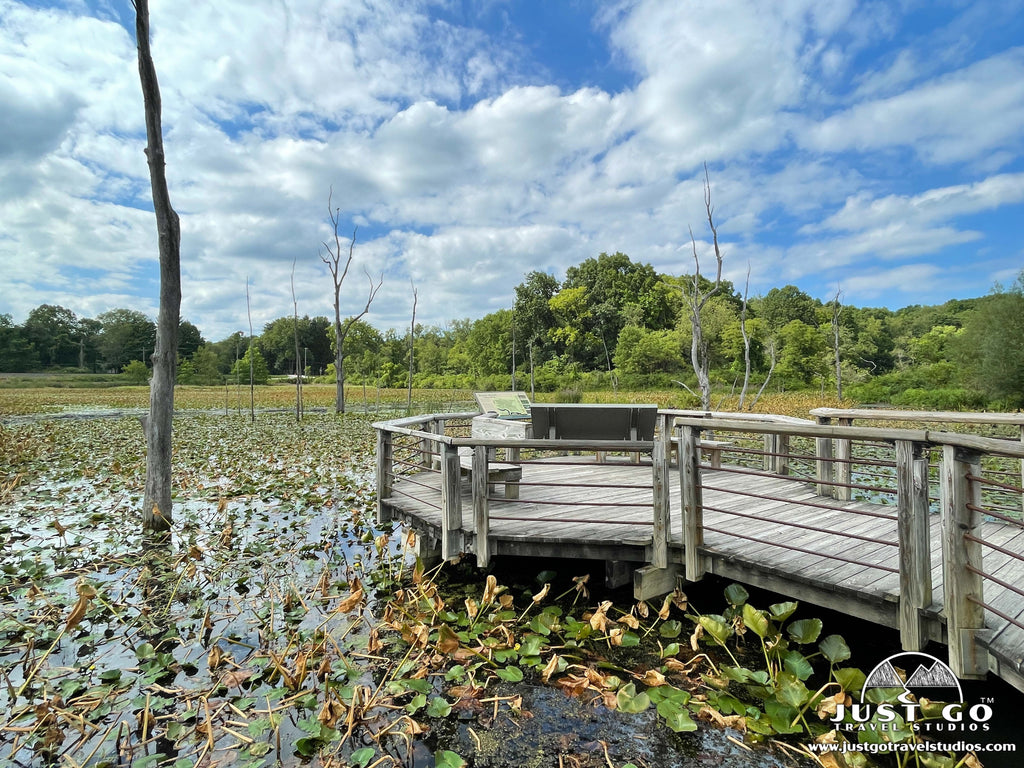
Hiking
Although the southern area of the park isn’t quite as populated with hiking trails, there are a few which can be accessed from the Everett Covered Bridge trailhead.
- If you’re looking for a short, family-friendly type of trail, check out the 2-mile Furnace Run Loop. Cross the road from the parking lot to ascend stairs and get the steep part out of the way. Then enjoy a mixture of flat terrain and gentle rolling hills before finishing your hike with the covered bridge. This is a popular trail in the spring for viewing wildflowers.
- For those seeking a more challenging trail, the 2.7-mile Perkins Loop is a good choice. Don’t let the easy beginning fool you! This trail has lots of roots and rocks, ups and downs and creek crossings. This trail is used by both hikers and horseback riders.
- The 4.6-mile Riding Run Loop is another option for those seeking a longer workout in the woods with obstacles like those on the Perkins Trail. Or combine Perkins Trail and Riding Run Loop for one big loop from the Everett Covered Bridge Trailhead.
For a closer look at some of these trails (in addition to many others at Cuyahoga Valley National Park), check out the Outdoor Adventure page for the Conservancy for Cuyahoga Valley National Park.
MORE THINGS TO DO AT CUYAHOGA VALLEY NATIONAL PARK
In addition to exploring hiking trails and the main park attractions, Cuyahoga Valley National Park visitors can enjoy a variety of other activities.
Biking
The Ohio and Erie Canal Towpath Trail is the most popular destination for cyclists at Cuyahoga Valley. The mixed-use Towpath Trail spans 101 miles—20 of which are inside the national park. Most of the miles in the national park are level and hard-packed, crushed limestone, although some sections are either paved or hard-packed dirt. Complete a short section or take an all-day trek through the park and beyond. Ride the trail as an out-and-back or take advantage of the Cuyahoga Valley Scenic Railroad Explorer Program. Load your bike onto the CVSR train for a one-way trip. Then pick the boarding station where you’d like to get off to bike back to your start along the Towpath Trail. If you don’t have a bike of your own, a few local businesses offer rentals.
Take a scenic train ride
A unique way to experience this national park is to ride the Cuyahoga Valley Scenic Railroad. See the Cuyahoga Valley Scenic Railroad website for tickets and trip planning information. The primary stations are Rockside (inside the park) and Akron Northside, with numerous stations in between. Days and hours of operation vary seasonally. So, be sure to check the schedule before planning your trip to Cuyahoga Valley if a train ride is on your must-do list! From June through October, you can hop on the train for a one-way trip and bike, hike or run back to your start for just a few dollars per person! There’s no need to book ahead for the CVSR Explorer Program. Just pay your one-way fee when boarding the train.

Paddle the river
If you’d like to canoe or kayak along the Cuyahoga River, you’ll have to bring your own equipment. The National Park Service does not rent equipment or maintain the river for recreation use. However, many have worked tirelessly for decades to clean up the Cuyahoga River, and it became an Ohio Water Trail in 2019. If you’re interested exploring these scenic waterways on your own, maps and information can be found on the Cuyahoga River Water Trail website.

Go birding
More than 200 species of birds either inhabit or migrate through Cuyahoga Valley making birding a popular activity in the park. Some popular locations for birding include Beaver Marsh, the Station Road Bridge, the Ledges (Virginia Kendall area) and the Bath Road Heronry. See the park website for more information on birding in Cuyahoga Valley.
MORE PLACES TO VISIT WITHIN AND BEYOND CUYAHOGA VALLEY NATIONAL PARK
If you have extra time while visiting Cuyahoga Valley, check out these nearby attractions. Our recommendations include:
- Szalay’s Farm & Market. During summer months, this old-fashioned farm market, located just off the Towpath Trail in Peninsula, is a great place to stop for fresh fruits and vegetables, preserves or some delicious baked goods! On summer and fall weekends, Szalay’s also offers an outdoor eatery serving corn on the cob, grilled sandwiches, and ice cream. Visit in the fall to wander through a challenging 3-acre corn maze!

- Hale Farm & Village. Located on 90 acres within the boundaries of the national park, Hale Farm and Village is a living history museum operated by the Western Reserve Historical Society (WRHS). Visit this historic farm and village in Bath, OH to learn what life was like on a farm in the 19th The museum features 32 historic buildings, heritage gardens and farm animals, plus cooking, craft, and trade demonstrations. Hale Farm & Village is open to the public June through October, Wednesday through Sunday. See the WRHS website for hours. Although the museum is located within the park, there is an admission fee since it is operated by Western Reserve Historical Society.

HOW TO GET TO CUYAHOGA VALLEY NATIONAL PARK AND OTHER TRAVEL INFORMATION
Cuyahoga Valley National Park is sandwiched between two sizable urban areas—Cleveland and Akron—making it easily accessible by car, bus, or train. It is also close to several major highways which makes travel convenient from other areas in the Midwest and several cities in the mid-Atlantic (for example, it is less than 2 hours from Pittsburg, PA and 3 hours from Buffalo, NY).
For those traveling from outside the area, there are two nearby airports offering daily service--Cleveland Hopkins International Airport and Akron-Canton Regional Airport. Both airports offer car rentals.
If you are passing through the park on a longer road trip, there is limited parking for oversized and recreational vehicles inside the park. RV and trailer parking is available in a designated lot across from the Boston Mill Visitor Center—allowing access to the visitor center, a boarding station for Cuyahoga Valley Scenic Railroad and the hiking trail to Blue Hen Falls. However, access to the rest of the park is limited since you’ll have no place to park if you are towing a trailer or driving an RV. We opted to stay at a nearby campground for a couple days to drop our trailer and fully explore the park. Overnight RV parking is not allowed at the designated oversized lot across from the visitor center or anywhere inside the national park.
WHERE TO STAY IN AND NEAR CUYAHOGA VALLEY NATIONAL PARK
With its urban location, there are numerous options just outside the park to suit all sorts of travelers. If you want to stay inside the park there are two options—the Inn at Brandywine Falls and Stanford House.
The historic Inn at Brandywine Falls is located right next to its namesake. Built in 1848 and listed on the National Register of Historic Places, this six-room bed and breakfast provides easy access to Brandywine Falls and nearby hiking trails.
If you are seeking overnight accommodation inside the park for a family reunion or team retreat, consider renting out the entire Stanford House. This historic farmhouse sleeps up to 30 and is centrally located inside the national park.
Camping near Cuyahoga Valley National Park: Cuyahoga Valley National Park no longer offers camping within the park. However, there are several campgrounds within a reasonable driving distance from the park. We thoroughly enjoyed our 2-night stay at West Branch State Park, located a little over a half hour east of Cuyahoga Valley. This large campground situated on a reservoir is open year-round and offers hook-ups, modern restrooms (some of the nicest we’ve seen!) with hot showers and laundry facilities, and a dump station. The campground fills up quickly during summer months. Campsite reservations at West Branch and other Ohio State Parks can be made up to six months in advance of your arrival date online at reserveohio.com.



WHEN IS THE BEST TIME TO VISIT CUYAHOGA VALLEY NATIONAL PARK?
Cuyahoga Valley National Park is open year-round. So, the best time of year to visit depends on what you want to see and do.
Summer provides the most activity options but is also the busiest season in the park. Summers in Ohio tend to be hot and humid. If you visit in the summer, plan to hit the trails early in the morning or late in the day to avoid the heat and the crowds.
Temperatures in the fall are ideal for hiking and biking the Towpath Trail. Leaves start changing in early October but mid-October is usually the best time to experience peak fall foliage in the park. Whether you visit in summer or fall, expect larger crowds on weekends, especially around popular attractions such as Brandywine Falls.
Spring rains combined with snow melt can make trails muddy; however, all that running water also makes it the best time to see waterfalls! Late spring can be an ideal time to visit when the temperatures are mild and wildflowers are in bloom.
Winter tends to be the quietest season in the park, but it is a great time to visit for those who enjoy winter activities, frozen waterfalls, and snowy trails.
NOTE: Cuyahoga Valley National Park is open 24 hours a day year-round but there are a few areas of the park that close at dusk. The following areas close from dusk until morning opening: Brandywine Falls, Ledges, Octagon, Kendall Lake, and Happy Days South parking area.
VISITING CUYAHOGA VALLEY NATIONAL PARK IN THE WINTER
There are many great ways to experience winter in Cuyahoga Valley National Park! Choose from activities like hiking, cross-country skiing, or downhill skiing!
Over 125 miles of park trails are open for hiking year-round. Winter hiking can be especially beautiful, and trails are rarely busy. Some great places to explore in the winter include Brandywine Falls, the Ledges and Blue Hen Falls. We recommend using microspikes on icy and snowy trails.
When the park is coated in snow, cross-country skiing and snowshoeing are also popular activities. A few trails recommended by the National Park Service include the Towpath Trail (easy multipurpose trail), Tree Farm Trail (easy/mod. XC ski), Oak Hill Trail (easy/moderate XC ski), and the Boston Run Trail (adv. intermediate XC ski).
If skiing downhill is more your speed, check out Boston Mills/Brandywine Ski Resort—two ski hills operated as one resort. Both locations offer lessons and rentals. You can also go tubing at the Polar Blast Snow Tubing Park (next to Brandywine).
See the NPS website for more information on winter sports at Cuyahoga Valley National Park.
Be sure to check the NPS website for current conditions in the park (including weather alerts and any closures).
IS THERE CELLULAR SERVICE IN CUYAHOGA VALLEY NATIONAL PARK?
Public WiFi is not available, but cellular service is generally good throughout the park.
ARE PETS ALLOWED AT CUYAHOGA VALLEY NATIONAL PARK?
Yes, leashed pets are welcome at Cuyahoga Valley National Park! Pets are allowed on over 100 miles of hiking trails in the park, including the multi-use Towpath Trail. They are not allowed in park buildings, on the Cuyahoga Valley Scenic Railroad, or on the East Rim mountain bike trails. Please check the NPS website for more information on visiting Cuyahoga Valley National Park with your pets.
Pets must always be kept on a leash no longer than six feet on park lands. Visitors are also required to clean up after their pets on all NPS land.
IS THERE AN ENTRANCE FEE TO VISIT CUYAHOGA VALLEY NATIONAL PARK?
No, Cuyahoga Valley National Park is a fee-free park! You heard me, right! There is no fee to enjoy the national park (or any of the Metro Parks nestled within or adjacent to park lands). However, if you’d like to support the park, please consider donating to the Conservancy for Cuyahoga Valley National Park.
RELATED INFORMATION ON CUYAHOGA VALLEY NATIONAL PARK FROM JUST GO TRAVEL STUDIOS
- Before your trip, don’t forget to download a copy of our Cuyahoga Valley National Park Itinerary & Hiking Guide!
- Be sure to check out nearby West Branch State Park!
- When you return from your trip, check out our custom, vintage travel posters that we make from photos you send to us! We love making them and they are our most popular product!
